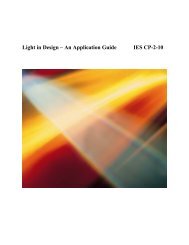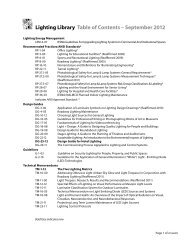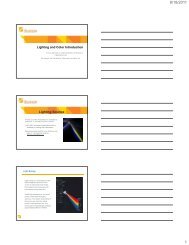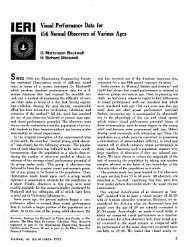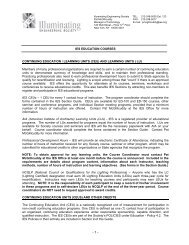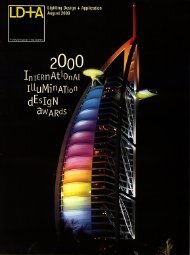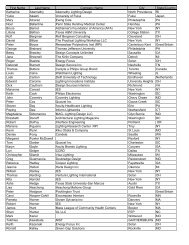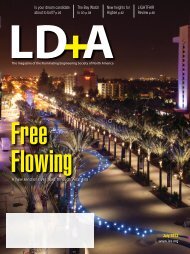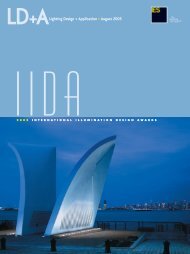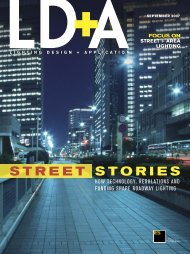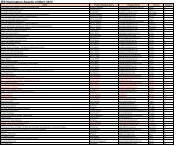Residential Lighting - Illuminating Engineering Society
Residential Lighting - Illuminating Engineering Society
Residential Lighting - Illuminating Engineering Society
You also want an ePaper? Increase the reach of your titles
YUMPU automatically turns print PDFs into web optimized ePapers that Google loves.
Iread Kevin Houser’s ‘<strong>Lighting</strong> For<br />
Quality’ in November’s LD+A and<br />
am very curious; unless I missed<br />
something, why there was no mention<br />
of the scotopic function and<br />
the work that Sam Berman, Don<br />
Jewett, Moji Navvab, Jim Sheedy<br />
and others have done on scotopically<br />
enhanced lighting.<br />
LETTERS<br />
TO THE EDITOR<br />
Based on good science, there is<br />
little doubt on the following points:<br />
• Rods are active at normal interior<br />
light levels<br />
• Rods are the main controller of<br />
pupil size<br />
• More scotopic color in light<br />
activates the rods = smaller pupils<br />
• Smaller pupils = better visual<br />
acuity and higher levels of brightness<br />
perception<br />
• These are important considerations<br />
in many working environments,<br />
especially with VDTs<br />
If the author wants to bring up<br />
any recent research that does not<br />
confirm advantages of scoptically<br />
enhanced lighting, I do not consider<br />
it relevant, if 20/20 visual considerations<br />
are not the governing criteria.<br />
Stan Walerczyk, LC<br />
Director of <strong>Lighting</strong><br />
Sun Industries<br />
Concord, CA<br />
Kevin Houser replies:<br />
Mr. Walerczyk’s last sentence<br />
struck me as remarkable. As I<br />
understand it, he does not consider<br />
spectral issues in lighting to<br />
be relevant unless they are about<br />
scotopically enhanced lighting<br />
and 20/20 visual considerations.<br />
Why would we limit ourselves to<br />
these topics Different lighting<br />
applications have different priorities;<br />
while 20/20 considerations<br />
like task visibility are often important,<br />
so is the color of human<br />
complexions, food, and merchandise,<br />
the brightness of room surfaces<br />
and objects, the visual efficiency<br />
of electric light sources,<br />
and perhaps above all the occupants’<br />
satisfaction with the lighting.<br />
These items are (partly)<br />
dependent upon spectral power<br />
distribution, of which the S/P<br />
ratio is just one of an infinite number<br />
of derived metrics. e.g. 1 - 28<br />
Recent research also shows that<br />
people may have different spectral<br />
needs for visibility and circadian<br />
photobiology; 29 as knowledge<br />
in this area grows it may<br />
influence architectural lighting<br />
practice and the spectral design<br />
of light sources. It is wrong to<br />
presume that scotopic enhancement<br />
is our only spectral variable,<br />
and unjustified to assume that it<br />
is the best way to improve the<br />
spectral performance of light<br />
sources.<br />
Furthermore, a careful reading<br />
of Berman’s work does not support<br />
Mr. Walerczyk’s conclusions<br />
about pupil size. While Berman’s<br />
work contains much good science,<br />
it is important to separate<br />
the facts from the speculations.<br />
Quoting Dr. Berman, “The spectral<br />
response of pupil size has<br />
been studied by several investigators<br />
but there is no consensus<br />
within the vision literature.” 1<br />
Berman and his coauthors have<br />
speculated that the scotopic<br />
function governs pupillary response,<br />
31-37 but, as far as I am<br />
aware, they have not tested this<br />
directly. Although it is not impossible<br />
to make physiological inferences<br />
from psychophysical experiments,<br />
it must be understood<br />
that these conclusions contain<br />
speculation. I believe that other<br />
viewpoints about pupil size and<br />
brightness perception have been<br />
prematurely dismissed or never<br />
addressed by Berman and his colleagues.<br />
For example, Alpern & Campbell<br />
38 and Doesschate & Alpern 39<br />
claim that pupil size is affected by<br />
both rods and cones, and that the<br />
action spectrum for pupillary<br />
response peaks midway between<br />
the photopic and scotopic functions<br />
(near 530 nm). Independently,<br />
Thornton has identified “a<br />
particular set of primaries as an<br />
invariant of the visual system,” 40<br />
and has termed the regions near<br />
450, 530, and 610 nm the “prime<br />
color” regions of human vision.<br />
Publisher<br />
William Hanley, CAE<br />
Editor<br />
Charles W. Beardsley<br />
Assistant Editor<br />
Roslyn Lowe<br />
Associate Editor<br />
John-Michael Kobes<br />
Art Director<br />
Anthony S. Picco<br />
Associate Art Director<br />
Samuel Fontanez<br />
Columnists<br />
Emlyn G. Altman<br />
Louis Erhardt • Stan Walerczyk<br />
Willard Warren<br />
Book Review Editor<br />
Paulette Hebert, Ph.D.<br />
Marketing Manager<br />
Sue Foley<br />
Advertising Coordinator<br />
Leslie Prestia<br />
Published by IESNA<br />
120 Wall Street, 17th Floor<br />
New York, NY 10005-4001<br />
Phone: 212-248-5000<br />
Fax: 212-248-5017/18<br />
Website: http://www.iesna.org<br />
Email: iesna@iesna.org<br />
LD+A is a magazine for professionals involved in the art,<br />
science, study, manufacture, teaching, and implementation<br />
of lighting. LD+A is designed to enhance and<br />
improve the practice of lighting. Every issue of LD+A<br />
includes feature articles on design projects, technical<br />
articles on the science of illumination, new product developments,<br />
industry trends, news of the <strong>Illuminating</strong><br />
<strong>Engineering</strong> <strong>Society</strong> of North America, and vital information<br />
about the illuminating profession.<br />
Statements and opinions expressed in articles and editorials<br />
in LD+A are the expressions of contributors and<br />
do not necessarily represent the policies or opinions of<br />
the <strong>Illuminating</strong> <strong>Engineering</strong> <strong>Society</strong> of North America.<br />
Advertisements appearing in this publication are the sole<br />
responsibility of the advertiser.<br />
LD+A (ISSN 0360-6325) is published monthly in the<br />
United States of America by the <strong>Illuminating</strong> <strong>Engineering</strong><br />
<strong>Society</strong> of North America, 120 Wall Street, 17th Floor,<br />
New York, NY. 10005, 212-248-5000. Copyright 2003 by<br />
the <strong>Illuminating</strong> <strong>Engineering</strong> <strong>Society</strong> of North<br />
America. Periodicals postage paid at New York, N.Y.<br />
10005 and additional mailing offices. Nonmember subscriptions<br />
$44.00 per year. Additional $15.00 postage for<br />
subscriptions outside the United States. Member subscriptions<br />
$30.00 (not deductible from annual dues).<br />
Additional subscriptions $44.00. Single copies $4.00,<br />
except <strong>Lighting</strong> Equipment & Accessories Directory and<br />
Progress Report issues $10.00. Authorization to reproduce<br />
articles for internal or personal use by specific<br />
clients is granted by IESNA to libraries and other users<br />
registered with the Copyright Clearance Center (CCC)<br />
Transactional Reporting Service, provided a fee of $2.00<br />
per copy is paid directly to CCC, 21 Congress Street,<br />
Salem, MA 01970. IESNA fee code: 0360-6325/86 $2.00.<br />
This consent does not extend to other kinds of copying<br />
for purposes such as general distribution, advertising or<br />
promotion, creating new collective works, or resale.<br />
POSTMASTER: Send address changes to LD+A, 120<br />
Wall Street, 17th Floor, New York, NY 10005. Subscribers:<br />
For continuous service please notify LD+A of<br />
address changes at least 6 weeks in advance.<br />
This publication is indexed regularly by <strong>Engineering</strong><br />
Index, Inc. and Applied Science & Technology Index.<br />
LD+A is available on microfilm from Proquest Information<br />
and Learning, 800-521-0600, Ann Arbor, MI<br />
4 LD+A/February 2003 www.iesna.org



